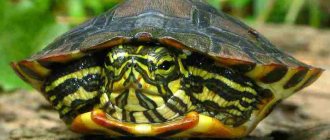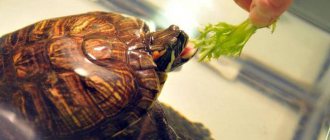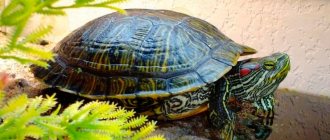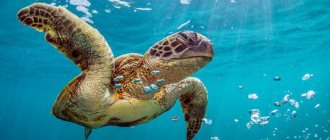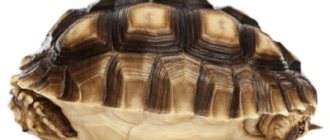To keep red-eared turtles at home, you need a properly equipped aquarium of adequate size. It would be more accurate to call it an aquaterrarium, since such a reservoir contains not only a body of water, but also an island of land. You can buy housing for turtles in special. stores or do it yourself.
Since the reptile is quite demanding about its place of residence, you need to know how to properly set up an aquarium for a red-eared slider. Your pet's home should be as close as possible to its natural habitat. Only in this case will your ward be healthy and happy in his own way.
A house for turtles and protection from bad weather and other animals
Domestic turtles in the countryside need a small house where they can rest and keep warm.
This is where you can give free rein to your imagination! Make a house out of boards and draw windows here together with your child. Make a semicircular hole for the entrance by sanding it. Lay hay on the floor of the house so that the turtle can rest comfortably here. Place a small pond nearby. You will need to pour enough water into the container so that its depth is equal to half the height of the turtle. From the remains of road tiles you can make a decorative path from the house to the pond, which will also decorate the country “terrarium”.
It is very important to consider a fence for the area where the turtle will live. Since these reptiles can dig, dig the bottom of the fence 30 cm deep into the ground
The height of this structure should be such that the turtle cannot climb up, which is what they like to do. Usually 50 cm is enough. You should not make a fence too high to make it convenient to bend down and perform some business operations here.
Since birds of prey, dogs, cats and cats can pose a danger to these small reptiles, it is better to cover the territory of the “aviary” from above. You can use a grid for this. Better yet, make something like a gable roof from boards or mesh, which is covered on top with roofing felt or waterproofing material. Then, even in the rain, the inside of the “terrarium” will be dry. If you forget to take your pet indoors in this weather, he won't get wet.
Shape and material required for a terrarium
A terrarium is a wide and long closed box, of small height, with special holes for ventilation.
The best material to use is non-toxic plastic, which is very light and easy to use. You can also try materials such as plexiglass, wood and regular glass. You can leave the transparent side through which you will open the turtle and feed it
It is important to take into account that in some cases turtles simply do not notice glass walls and often hit the glass with their shells. In this case, it would be better to glaze the walls with a beautiful terrarium background
The terrarium can be made in the shape of a square or rectangle. It is very practical when, when opening the terrarium, you can slide the glass out of special grooves or simply remove the glass, which is attached to special magnets. The height of the side should be made no less than 10-20 cm in order to conveniently pour soil there and so that the turtle does not have the opportunity to crawl out.
Appearance
Young red-eared turtles are bright green. As they grow up, they darken. The neck and limbs of the turtle are covered with variegated stripes, white and green. Behind the eyes, the turtle's head is decorated with elongated red spots, for which it is called the red-eared turtle.
During the first 2 years of life, the domestic red-eared slider grows rapidly and reaches up to 20 cm in length. Subsequently, the growth rate decreases to 1.5 cm per year. The lifespan of red-eared turtles is 30 years or more. Therefore, when purchasing a cute little turtle, keep in mind that you are starting a long relationship with a fairly large pet.
The advantage of an aviary
Arranging a turtle enclosure requires some investment of money, as well as the availability of free time. However, by designing an enclosure for turtles, you will be able to observe the behavioral characteristics of your pet in the wild.
Before building an enclosure, you need to make some preparations, make a kind of diagram and purchase the necessary materials. If you prepare and purchase everything in advance, the process of constructing an enclosure will not take more than an hour. After the end of the warm period, the pen can be disassembled and placed somewhere for preservation, and next year it can be reassembled so that your beloved turtle can enjoy the summer with you.
Selecting a location
Before you decide to build enclosures for land turtles with your own hands, you need to decide on a suitable location. Quite suitable:
- Apartment balcony.
- Dacha yard.
- Country greenhouse.
By creating an enclosure for turtles on the balcony of your apartment, you can protect your pet from wild animals that can easily enter the yard of your dacha, and you will also protect the turtle from unexpected precipitation. However, the disadvantage of such a pen is the limited amount of free space.
The area for the location of the enclosure must be chosen very carefully, because due to its low location, in the event of rain, the enclosure can turn into a swimming pool. Some kind of hill or small hill is best. For one turtle, 4 sq.m. is enough. free space, but you can take much more, as much as the territory allows you.
Which turtle should you choose?
Among land turtles there are some very interesting specimens. On average, these reptiles live 30 years in captivity. That is, with proper care and nutrition, they will become little friends of adults and children for many years.
Pay attention to the following breeds of land turtles:
The Central Asian turtle reaches a size of 10-18 cm. These land turtles have dark scutes on a light carapace. But these reptiles are not very fond of games; they prefer a quiet pastime. Therefore, for families with small children, it is probably better to purchase a pet turtle of a different breed
It is necessary to pour sand into the territory where the Central Asian tortoise will live, where these animals like to swarm even in the heat. If you want a larger turtle - up to 35 cm in size, then pay attention to the Mediterranean. These animals come in speckled or plain colors.
They have interesting spurs on their hind legs. A beautiful reptile with an original shell is the star tortoise, also called the Indian tortoise. She has a beautiful shell, which is decorated with peculiar stars. Their yellow pattern stands out well against a dark background. The size of males is 15, females - 25 cm.
The Balkan tortoise is similar in color to the Mediterranean tortoise. But with age, its color becomes duller. These are the turtles that are best suited for families with children, as they are very active, especially in the summer. The size of such a reptile is about 20 cm.
The Egyptian tortoise is smaller - only 12 cm. These animals have a sand-colored shell, which is decorated with a dark pattern. But Egyptian tortoises, unfortunately, have weak immunity, are susceptible to disease, and must be treated with great attention.
Central Asian turtle. ulih.Star, or Indian, turtle. Pochacco_andrewBalkan tortoise. The Reptilarium
Description
The red-eared turtle is a medium-sized reptile, which, depending on its gender, has a length of the upper part of the shell (carapace) from eighteen to thirty centimeters. The body of the reptile is hidden in a reliable and durable shell, which consists of bone covered with horny plates. The thin long tail, head and limbs remain outside and, in case of danger, are retracted under the armored shields.
The head of the individual is covered with a hard horny covering, which successfully compensates for its lack of teeth, forming sharp edges on the edge of the jaws. The red-eared slider spends most of its life in the water, having webbed swimmers on its hind legs and flattened forelimbs.
The red-eared turtle has undeveloped vocal cords and therefore can snort in excitement and hiss in defense. The individual has a fairly developed sense of smell and vision, and its eyes, which are located on the sides, are reliably protected by movable eyelids. Despite the underdeveloped hearing, the reptiles navigate well by it and hide in the water at any rustle.
In the area of the reptile's ears there are spots or stripes of red color, and in some of its subspecies they can be yellow. Nature has generously endowed the Red-eared turtle with an unusual and amazing shell pattern, the continuation of which can be seen on its limbs and head in the form of green and white wavy spots and stripes. The oval lower part of the shell (plastron) of the individual is dark in color with yellow lines. Young carapace has a bright green color, which becomes yellow-brown or olive with age. The life expectancy of the reptile is thirty years.
What properties should a corral fence have?
- First of all, the fence should serve as an undeniable barrier along the entire perimeter.
- The opacity of the fence will not encourage the turtle to look for a way out of the enclosure.
- The smooth surface of the fence will not allow your claws to catch on it.
- The fence should protect from the wind and not let out heat.
- If necessary, the owner must overcome the fence without delay and have an unobstructed view of the entire territory of the enclosure.
- The fence should not only be reliable, but also aesthetically pleasing to the eyes of the owners.
- Materials from which you can build a fence can be found on every site: concrete slabs and stones, boards, wooden beams, etc.
The size of the enclosure, as well as its design, depend on whether the animals will be in it only in the summer, or whether they will live there all year round. During the cold season, pets can be kept in greenhouses, which have a special compartment for turtles.
In the enclosure, it is a good idea to plant green treats for turtles, such as lettuce, clover, cucumbers, dandelions, pumpkins, lavender and many others. You just need to make sure that the plants do not grow close to the fence, especially climbing ones. In this case, the turtle will have an extra chance to leave the enclosure.
A good soil for turtles would be a mixture of river sand with small stones, which should replace part of the soil in the pen. Pesos
By day it will heat up, and at night it will give off heat to the turtle, which can burrow into it.
What to feed your pet turtle?
This is easiest to do in the summer, since already in the spring the first grass begins to appear, which the turtles eat with pleasure. Therefore, in the summer at the dacha there should be no problems with feeding land turtles. The main thing is to exclude some crops from the menu of this armored animal.
In addition to the prohibited plants listed above, land turtles should not eat:
- crickets;
- garlic, onion;
- eggshells;
- milk;
- bread;
- some cereals (with the exception of rolled oats);
- cherry;
- citrus fruit peel;
- berry seeds;
- prepared meat products in the form of sausages, frankfurters.
This is what the ideal diet for a land turtle looks like:
- 75% greens;
- 15% berries, fruits and vegetables;
- 5% oatmeal porridge;
- 5% special vitamin or mineral supplements that can be purchased at any pet store.
For greens, offer your turtle dandelion leaves, lettuce, alfalfa, plantain, lawn grass, and sorrel. Also, these animals will not refuse the stems and leaves of beans, peas, and the inflorescences of plants that are useful to them.
Turtles should always have greens in their feeder. This is the main component of their diet. As vegetables, you can offer these reptiles fresh carrots, pumpkin, ripened zucchini, radishes, and young beets. You can also give beet tops to animals infrequently.
The fruit and berry diet of turtles consists of strawberries, raspberries, apricots, and watermelon. But fruits and berries should be given to them in small quantities, like dessert.
Sometimes land turtles need to be offered meat. It is doused with boiling water and cut into small pieces. But it is better to boil the meat to eliminate the possibility of harmful microorganisms in it.
If the turtle has a bath filled with fresh water, reaching up to half its height, then the animal will be able to climb here and quench its thirst. The fact is that land turtles obtain their moisture supply not only from water and the juicy foods they consume, but also from the absorption of water into the skin. Make sure that it is comfortable for the animal to crawl into such a bath, and that the water is always clean and warmed up in the sun.
By the way, these animals need sunlight. That is why most of the country “terrarium” should be in the sun. Then calcium in the turtle’s body will be better absorbed. By the way, staying in the fresh air for land turtles is a prerequisite for their health and longevity. For a turtle, spending the summer at the dacha is happiness!
For greens, offer your turtle dandelion leaves, lettuce, alfalfa, plantain, lawn grass, and sorrel. Nigel Barnett
How to set up an aquarium
If you decide to set up an aquarium for your red-eared slider yourself, follow the design rules. Familiarize yourself with the requirements for setting up an aquarium for a red-eared slider before purchasing a tank, since you should start with volume.
The main factors that require attention when designing an aquarium for a red-eared turtle:
- water;
- land;
- temperature regime;
- light;
- ultraviolet;
- filter;
- priming;
- decorations.
Volume
The volume of the tank is selected according to the number and size of individuals. If a small turtle has settled in the house, you need to take a tank for growth. A small turtle the size of an apricot kernel will eventually grow to the size of a tea plate.
The volume of the tank is selected according to size:
- 3-10 cm: 50 liters;
- 10-16 cm: 80 liters;
- 17-35 cm: 150 liters;
- from 35 cm: over 160 liters.
Water temperature
Optimal water temperature: 22-28 degrees. Temperature on land: no more than 32 degrees. You can put two islands in an aquaterrarium: one in the shade, the second under a lamp. In the shade it is necessary to maintain a temperature regime of 20-25 degrees, and on the illuminated side - 28-32 degrees.
How much water should be poured
Although the animal spends a lot of time on land, it needs water. There should be enough water in the aquarium for the animal to swim. Water should occupy half the area of the tank. Water changes should be done once a week. 20% of the volume must be replaced at a time.
Aquarium filter
The water in the tank must be cleaned regularly. To do this, an external filter is placed in the turtle aquarium. Internal filter elements are not suitable: they clog quickly and do a poor job of filtering. The better the filter works, the less often the water is replaced.
Lighting
It is necessary to secure a lamp in the tank, as turtles need additional lighting. They are heated under a lamp on the island, so it is worth placing the lighting elements above the island. When installing a lamp, you need to monitor the temperature under it. On the island, the temperature cannot exceed 32 degrees. Energy-saving lamps are not suitable for turtles; it is better to buy and install a simple 220V light bulb. At night, the lights are turned off so that the animal can fully rest.
Ultraviolet lighting
Many turtle owners do not buy ultraviolet lamps, considering it an unnecessary expense. But it's not right. Installing an ultraviolet lamp is vital for the animal.
Without ultraviolet light, turtles often get sick, which can cause sudden death of the animal. Ultraviolet radiation has a positive effect on metabolism, strengthens the armor layer of the skin, and accelerates the absorption of calcium.
An ultraviolet lamp can be ordered in specialty stores. It is fixed at a height of 30 cm from the land area. The ultraviolet source must shine for at least 12 hours a day.
Ground coating
It is not necessary to buy soil for the aquarium for the red-eared slider. But they can beautifully decorate a turtle’s house. The bottom of the tank and islands are lined with soil. But not every ground cover is suitable for a turtle.
The bottom of the tank can be lined with large, smooth stones; pebbles will do. The size of the stones must be larger than 5 cm. An animal can eat small stones, which will cause serious complications or even the death of the animal.
Sand is suitable for the soil, but keep in mind that then cleaning will take a lot of time.
You can decorate the tank with shells. They enrich the water with calcium and are beneficial for the animal. But you will have to give up plastic or glass decorations.
Vegetation and decor
There is no need to buy live vegetation for the aquaterrarium. She will quickly find plants and bite them or simply damage them. If you don't have enough decor, use artificial green spaces. They should be securely fastened to the bottom.
How to equip an aquazone: you can decorate the bottom with driftwood, multi-colored smooth pebbles, but you cannot put fresh pieces of wood, they must be made of water.
When choosing decor, make sure there are no sharp edges or jagged edges. Any decorations must be safe for the animal. Don't buy small jewelry. They will be eaten by turtles.
Selection of materials
A mistake many tortoise owners make is choosing a terrarium made entirely of glass. Like humans, reptiles also need peace. In a glass terrarium they will always be in sight
Any careless movement, bright light and shadow fluctuations will disturb the turtle's peace. As a result, an impressionable reptile may experience constant stress, which will negatively affect its health.
The best option for a terrarium would be a combination of glass and high-quality plywood. Only the front part of the product should be made of glass. Everything else will consist of opaque plywood. You can use other materials suitable for this purpose.
Content Features
The red-eared turtle is quite demanding in terms of living conditions. When purchasing such a pet, you need to understand that the size of the aquarium does not have any effect on the size of the reptile. Even in a small container the animal will grow, but will become weak and sick.
To provide your reptile with comfortable living conditions, you must purchase the following:
- aquarium for turtles with a volume of 150 l;
- 100 Watt water heater;
- external filter;
- ultraviolet lamp for aquatic turtles with UVB 10%;
- heating lamp;
- lighting lamp;
- thermometer;
- sushi element.
The aquarium consists of a number of elements



